Thermal Characteristics of Tube Bundles in Ultra-Supercritical Boilers
Abstract
:1. Introduction
2. Experimental Method
2.1. Experimental Apparatus
2.2. Data Reduction
2.3. Numerical Simulation Method
3. Results and Discussion
3.1. Flow Characteristics
3.2. Heat Transfer Characteristics
4. Conclusions
Acknowledgments
Author Contributions
Conflicts of Interest
Nomenclature
| CFB | circulating fluidized bed |
| Dnaph | mass diffusion coefficient of naphthalene vapor in air (m2/s) |
| hm | mass transfer coefficient (m/s) |
| LVDT | linear variable differential transformer |
| local naphthalene mass transfer rate per unit area (kg/(m2·s)) | |
| Nu | Nusselt number |
| NuD | Total area averaged Nusselt number |
| Pr | Prandtl number |
| Re | Reynolds number |
| ReD | Reynolds number based on diameter of the tube bundle |
| S | distance between tube bundles |
| Sc | Schmidt number |
| Sh | Sherwood number |
| SOFA | separated overfire air |
| Sx/D | gradient of the tube bundles in the streamwise direction |
| Sz/D | gradient of the tube bundles in the spanwise direction |
| Δt | run time (s) |
| USC | ultra-supercritical |
| x | coordinate in the x-direction |
| y | coordinate in the y-direction |
| z | coordinate in the z-direction |
| Δz | sublimation depth of naphthalene surface (m) |
Greek Symbols
| density of solid naphthalene at the surface (kg/m3) | |
| vapor density of naphthalene at the surface (kg/m3) | |
| vapor density of naphthalene in the main stream (kg/m3) | |
| coordinate in tangential direction | |
| tube bundle diameter (mm) |
References
- International Energy Agency (IEA). Key world energy statistics. 2015. Available online: https://www.iea.org/publications/freepublications/publication/KeyWorld2016.pdf (accessed on 27 July 2016).
- Ultra Super Critical Pressure Coal Fired Boiler—State of the Art Technology Applications. Available online: https://www.yumpu.com/en/document/view/40407524/ultra-supercritical-pressure-coal-fired-boiler/1 (accessed on 23 September 2016).
- Dekhtiarev, V.L. On designing a large, highly economical carbon dioxide power installation. Elektr. Stantsii 1962, 5, 1–6. [Google Scholar]
- Feher, E.G. The supercritical thermodynamic power cycle. Energy Convers. 1968, 8, 85–90. [Google Scholar] [CrossRef]
- Kang, K.T.; Song, J.H.; Yoon, M.J.; Lee, B.H.; Kim, S.M.; Chang, Y.J.; Jeon, C.H. A numerical study on the effects of SOFA on NOx emission reduction in 500MW class sub-bituminous coal-fired boiler. Trans. Korean Soc. Mech. Eng. B 2009, 33, 858–868. [Google Scholar] [CrossRef]
- Pan, J.; Yang, D.; Chen, G.; Zhou, X.; Bi, Q. Thermal-hydraulic analysis of a 600 MW supercritical CFB boiler with low mass flux. Appl. Therm. Eng. 2012, 32, 41–48. [Google Scholar] [CrossRef]
- Fan, Z.; Goidich, S.; Robertson, A.; Wu, S. Ultra-supercritical pressure CFB boiler conceptual design study. Foster Wheel. Dev. 2006. [Google Scholar] [CrossRef]
- Hou, G.; Yang, Y.; Jiang, Z.; Li, Q.; Zhang, J. A new approach of modeling an ultra-super-critical power plant for performance improvement. Energies 2016, 9, 310. [Google Scholar] [CrossRef]
- Wang, L.; Yang, Y.; Morosuk, T.; Tsatsaronis, G. Advanced thermodynamic analysis and evaluation of a supercritical power plant. Energies 2012, 5, 1850–1863. [Google Scholar] [CrossRef]
- Xu, G.; Xu, C.; Yang, Y.; Fang, Y.; Li, Y.; Song, X. A novel flue gas waste heat recovery system for coal-fired ultra-supercritical power plants. Appl. Therm. Eng. 2014, 67, 240–249. [Google Scholar] [CrossRef]
- Yang, Y.; Wang, L.; Dong, C.; Xu, G.; Morosuk, T.; Tsatsaronis, G. Comprehensive exergy-based evaluation and parametric study of a coal-fired ultra-supercritical power plant. Appl. Energy 2013, 112, 1087–1099. [Google Scholar] [CrossRef]
- Liu, X.J.; Kong, X.B.; Hou, G.L.; Wang, J.H. Modeling of a 1000MW power plant ultra super-critical boiler system using fuzzy-neural network methods. Energy Convers. Manag. 2013, 65, 518–527. [Google Scholar] [CrossRef]
- Viswanathan, R.; Coleman, K.; Rao, U. Materials for ultra-supercritical coal-fired power plant boilers International. J. Press. Vessel. Pip. 2006, 83, 778–783. [Google Scholar] [CrossRef]
- Viswanathan, R.; Henry, J.F.; Tanzosh, J.; Stanko, G.; Shingledecker, J.; Vitalis, B.; Purgert, R. US program on materials technology for ultra-supercritical coal power plants. J. Mater. Eng. Perform. 2005, 14, 281–292. [Google Scholar] [CrossRef]
- Castello, P.; Guttmann, V.; Farr, N.; Smith, G. Laboratory-simulated fuel-ash corrosion of superheater tubes in coal-fired ultra-supercritical-boilers. Mater. Corros. 2000, 51, 786–790. [Google Scholar] [CrossRef]
- Lee, N.H.; Kim, S.; Choe, B.H.; Yoon, K.B.; Kwon, D.I. Failure analysis of a boiler tube in USC coal power plant. Eng. Fail. Anal. 2009, 16, 2031–2035. [Google Scholar] [CrossRef]
- Krauss, T.; Meyer, L. Experimental investigation of turbulent transport of momentum and energy in a heated rod bundle. Nucl. Eng. Des. 1998, 180, 185–206. [Google Scholar] [CrossRef]
- Chen, H.; Wang, Y.; Zhao, Q.; Ma, H.; Li, Y.; Chen, Z. Experimental investigation of heat transfer and pressure drop characteristics of H-type finned tube banks. Energies 2014, 7, 7094–7104. [Google Scholar] [CrossRef]
- Yeo, W.H.; Fry, A.T.; Purbolaksono, J.; Ramesh, S.; Inayat-Hussain, J.I.; Liew, H.L.; Hamdi, M. Oxide scale growth and presumed exfoliation in a 700 °C or higher steam condition: A simulation study for future operations of ultra-supercritical power plants. J. Supercrit. Fluid. 2014, 92, 215–222. [Google Scholar] [CrossRef]
- Yuan, Y.; Zhong, Z.H.; Yu, Z.S.; Yin, H.F.; Dang, Y.Y.; Zhao, X.B.; Gu, Y. Tensile and creep deformation of a newly developed Ni-Fe-based superalloy for 700 °C advanced ultra-supercritical boiler applications. Met. Mater. Int. 2015, 21, 659–665. [Google Scholar] [CrossRef]
- Metzger, D.E.; Berry, R.A.; Bronson, J.P. Developing heat transfer in rectangular ducts with staggered arrays of short tube fins. J. Heat Transf. 1982, 104, 700–706. [Google Scholar] [CrossRef]
- Armstrong, J.; Winstanley, D. A review of staggered array tube fin heat transfer for turbine cooling applications. J. Turbomach. 1988, 110, 94–103. [Google Scholar] [CrossRef]
- Sparrow, E.M.; Suopys, A.P.; Ansari, M.A. Effect of inlet, exit, and fin geometry on tube fins situated in a turning flow. Int. J. Heat Mass Transf. 1984, 27, 1039–1054. [Google Scholar] [CrossRef]
- Goldstein, R.J.; Chyu, M.K.; Hain, R.C. Measurement of local mass transfer on a surface in the region of the base of a protruding cylinder with a computer-controlled data acquisition system. Int. J. Heat Mass Transf. 1985, 28, 977–985. [Google Scholar] [CrossRef]
- Chyu, M.K.; Hsing, Y.C.; Shih, T.P.; Natarajan, V. Heat transfer contributions of tubes and endwall in tube-fin arrays: effects of thermal boundary condition modeling. J. Turbomach. 1999, 121, 257–263. [Google Scholar] [CrossRef]
- Ji, J.; Ge, P.; Bi, W. Numerical analysis on shell-side flow-induced vibration and heat transfer characteristics of elastic tube bundle in heat exchanger. Applied. Therm. Eng. 2016, 107, 544–551. [Google Scholar] [CrossRef]
- Eter, A.; Groeneveld, D.; Tavoularis, S. An experimental investigation of supercritical heat transfer in a three-rod bundle equipped with wire-wrap and grid spacers and cooled by carbon dioxide. Nucl. Eng. Des. 2016, 303, 173–191. [Google Scholar] [CrossRef]
- Zhang, L.Z.; Ouyang, Y.W.; Zhang, Z.G.; Wang, S.F. Oblique fluid flow and convective heat transfer across a tube bank under uniform wall heat flux boundary conditions. Int. J. Heat Mass Transf. 2015, 91, 1259–1272. [Google Scholar] [CrossRef]
- Shen, S.; Liu, H.; Gong, L.; Yang, Y.; Liu, R. Thermal analysis of heat transfer performance in a horizontal tube bundle. Desalination Water Treat 2015, 54, 1809–1818. [Google Scholar] [CrossRef]
- Pis’mennyi, E.N.; Terekh, A.M.; Polupan, G.P.; Carvajal-Mariscal, I.; Sanchez-Silva, F. Universal relations for calculation of the drag of transversely finned tube bundles. Int. J. Heat Mass Transf. 2014, 73, 293–302. [Google Scholar] [CrossRef]
- Ambrose, D.; Lawrenson, I.J.; Sparke, C.H.S. The vapor pressure of naphthalene. J. Chem. Thermodyn. 1975, 7, 1173–1176. [Google Scholar] [CrossRef]
- Goldstein, R.J.; Cho, H.H. A review of mass transfer measurements using naphthalene sublimation. Exp. Therm. Fluid Sci. 1995, 10, 416–434. [Google Scholar] [CrossRef]
- Eckert, E.R.G.; Drake, R.M., Jr. Analysis of Heat and Mass Transfer; Hemisphere Publishing: New York, NY, USA, 1987; pp. 306–383. [Google Scholar]
- Abernethy, R.B. ASME measurement uncertainty. J. Fluid. Eng. 1987, 107, 161–164. [Google Scholar] [CrossRef]
- Žkauskas, A. Heat transfer from tubes in crossflow. Adv. Heat Transf. 1987, 18, 87–159. [Google Scholar]
- Giedt, W.H. Investigation of variation of point unit heat-transfer coefficient around a cylinder normal to an air stream. Trans. ASME 1949, 71, 375–381. [Google Scholar]
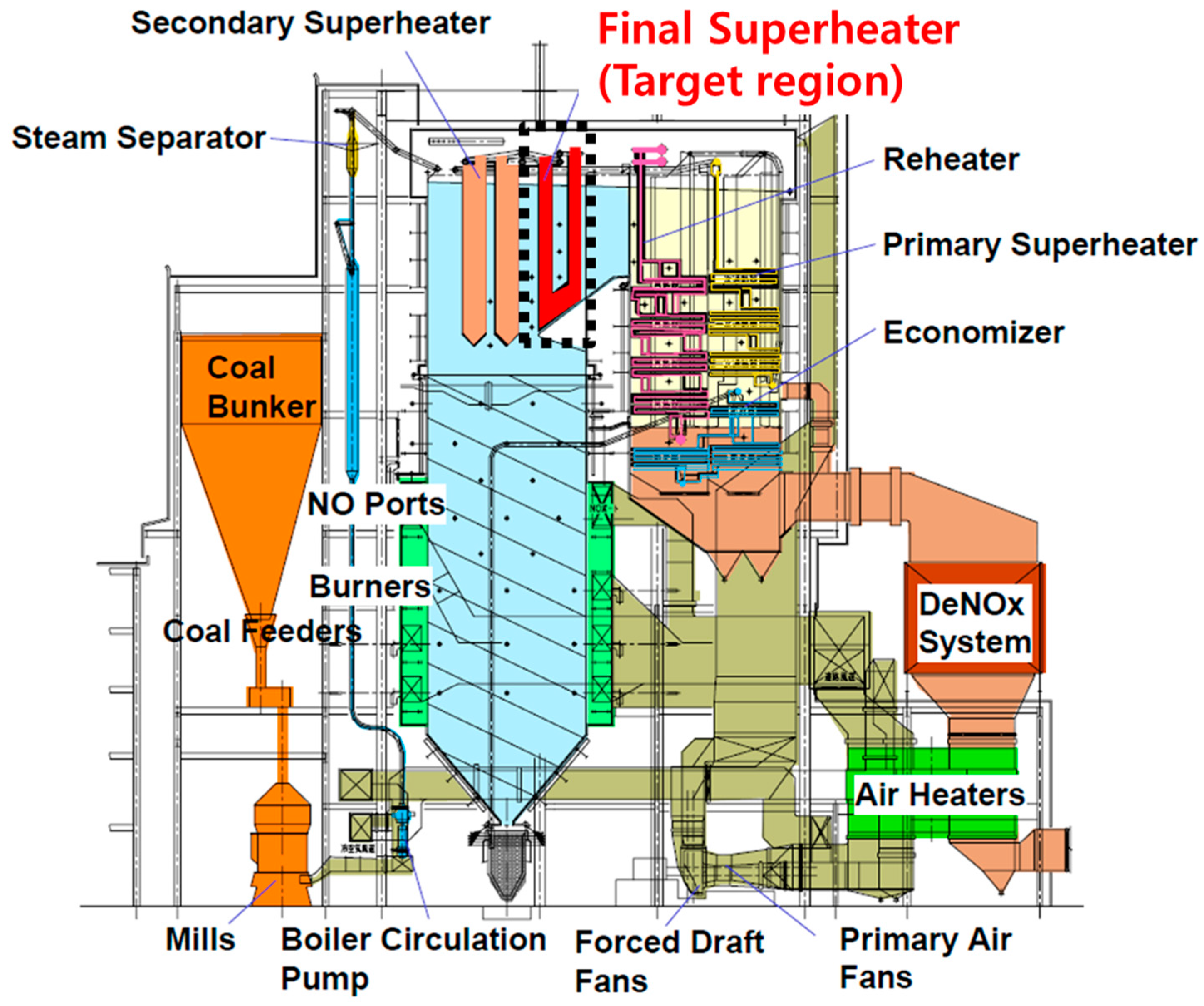
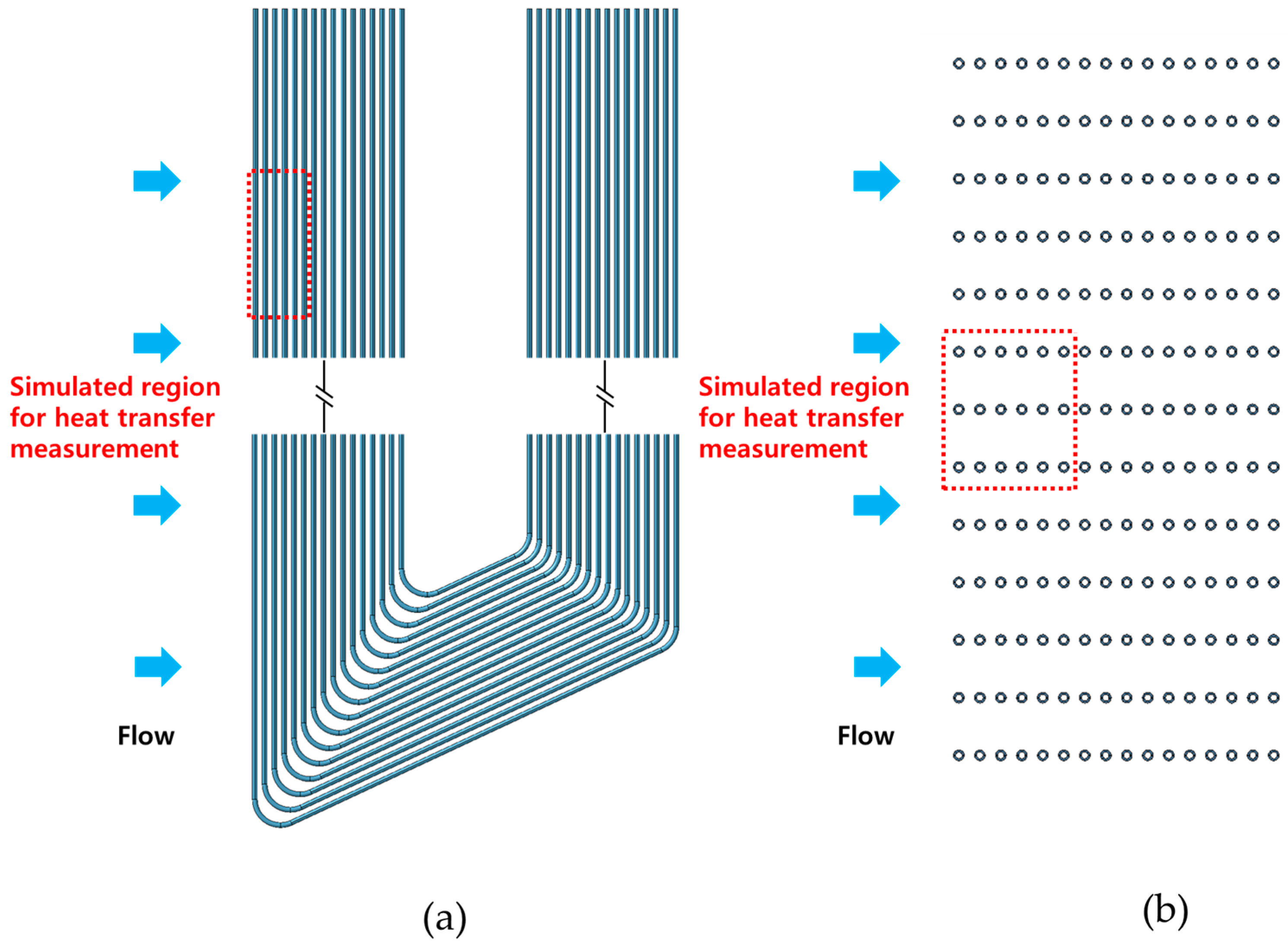
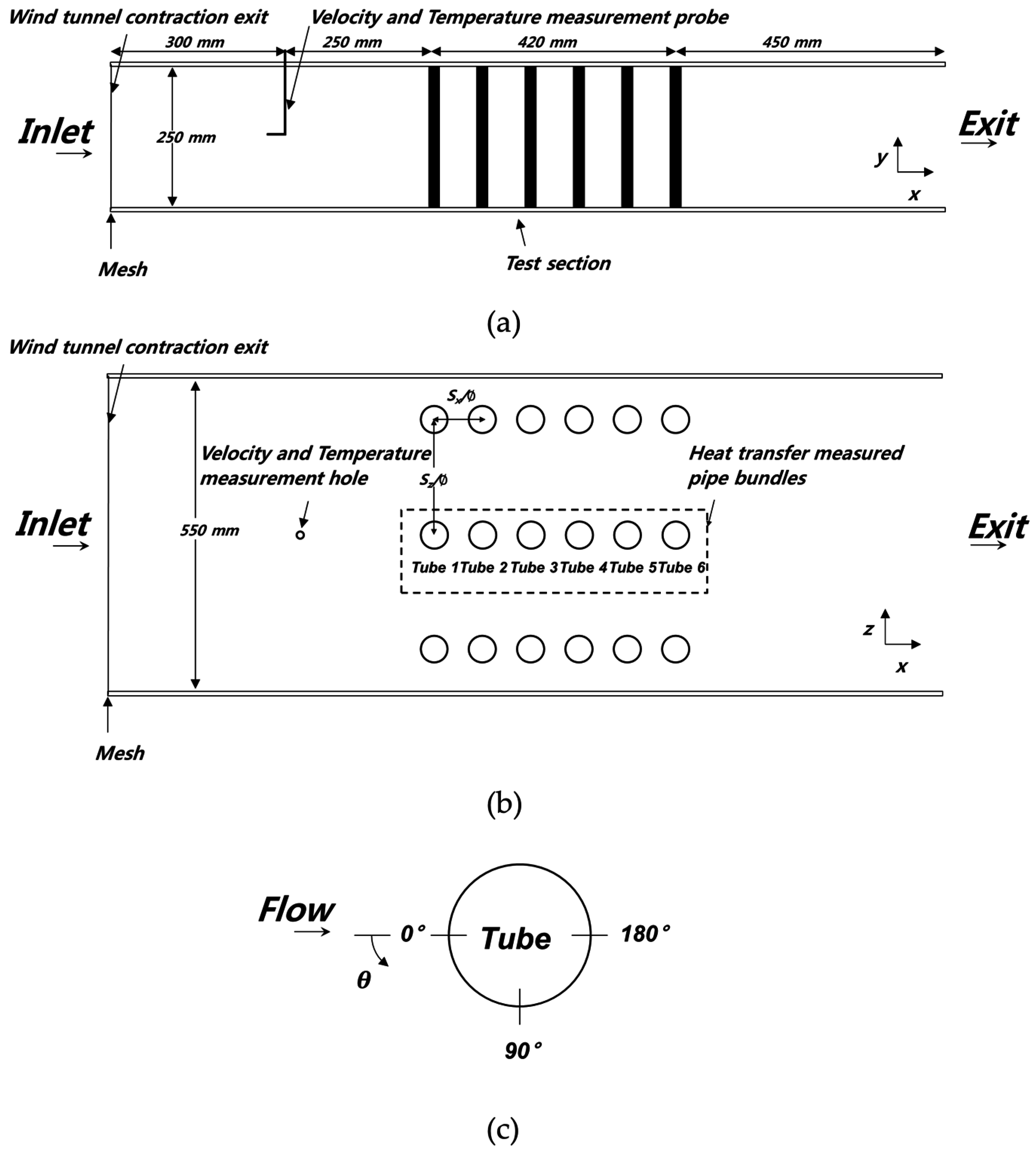
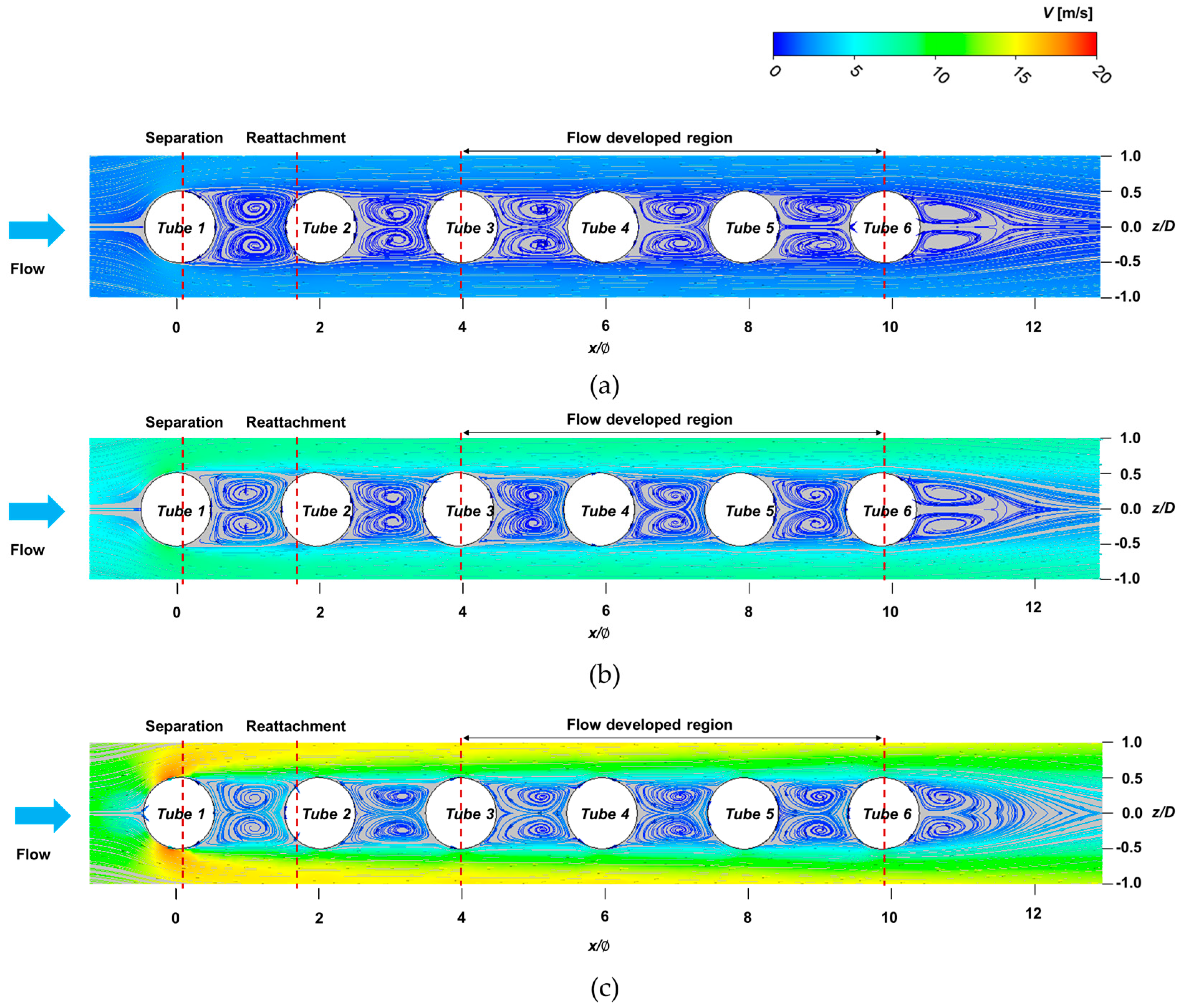
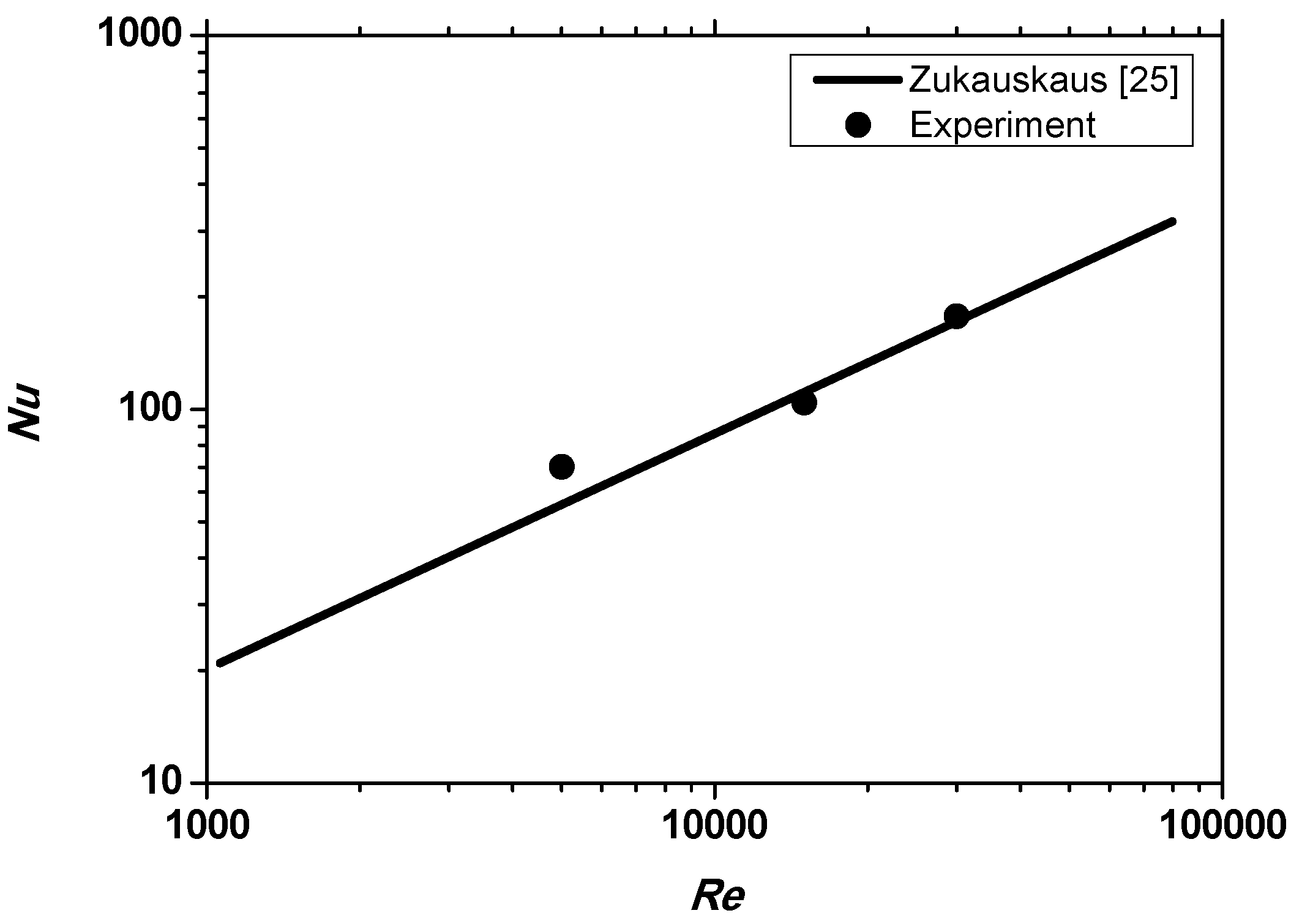
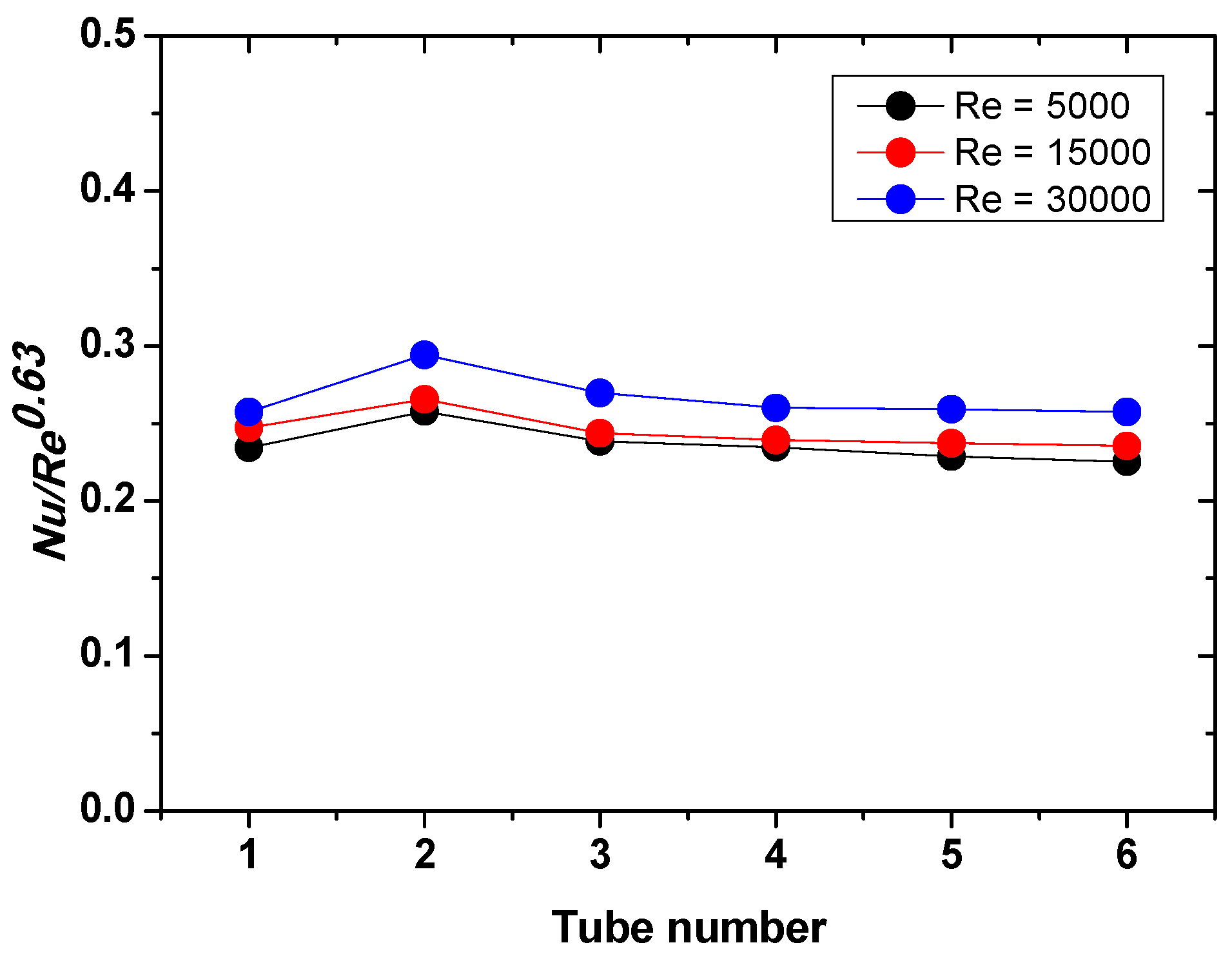
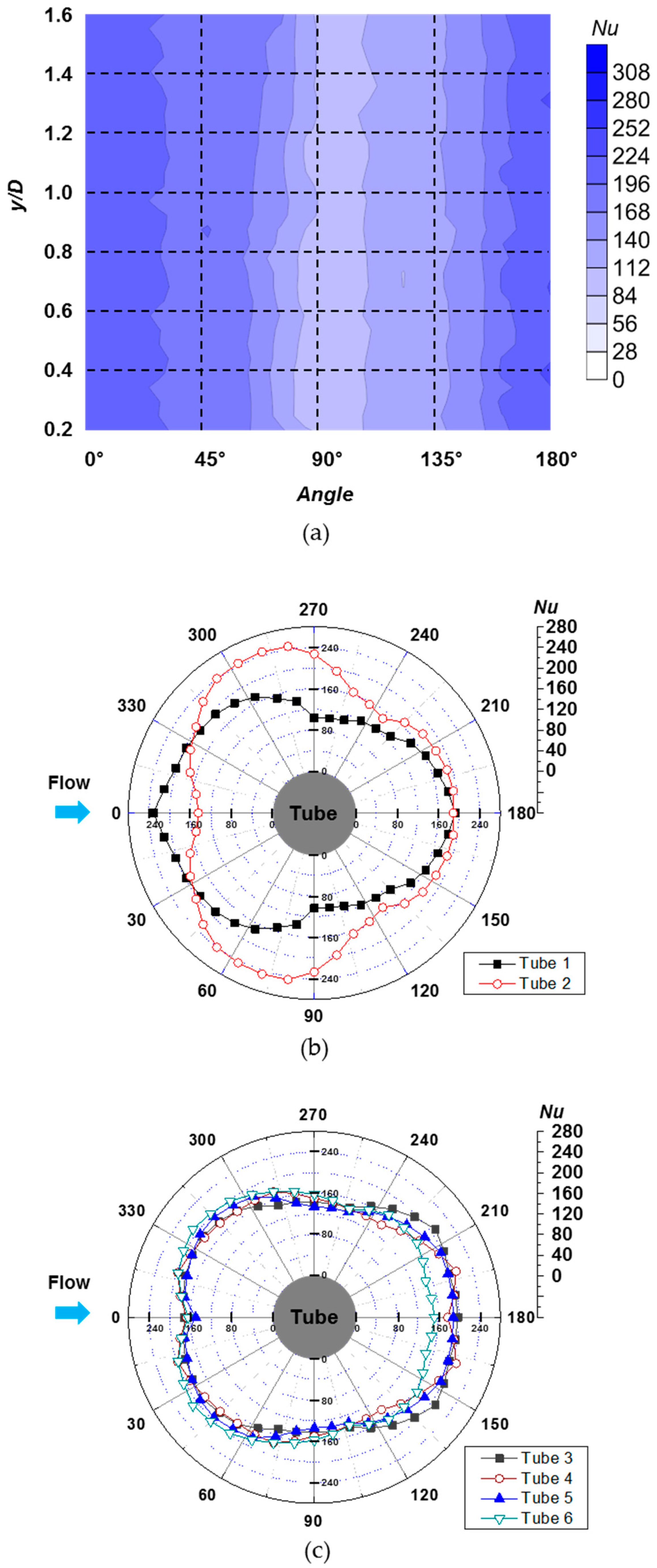

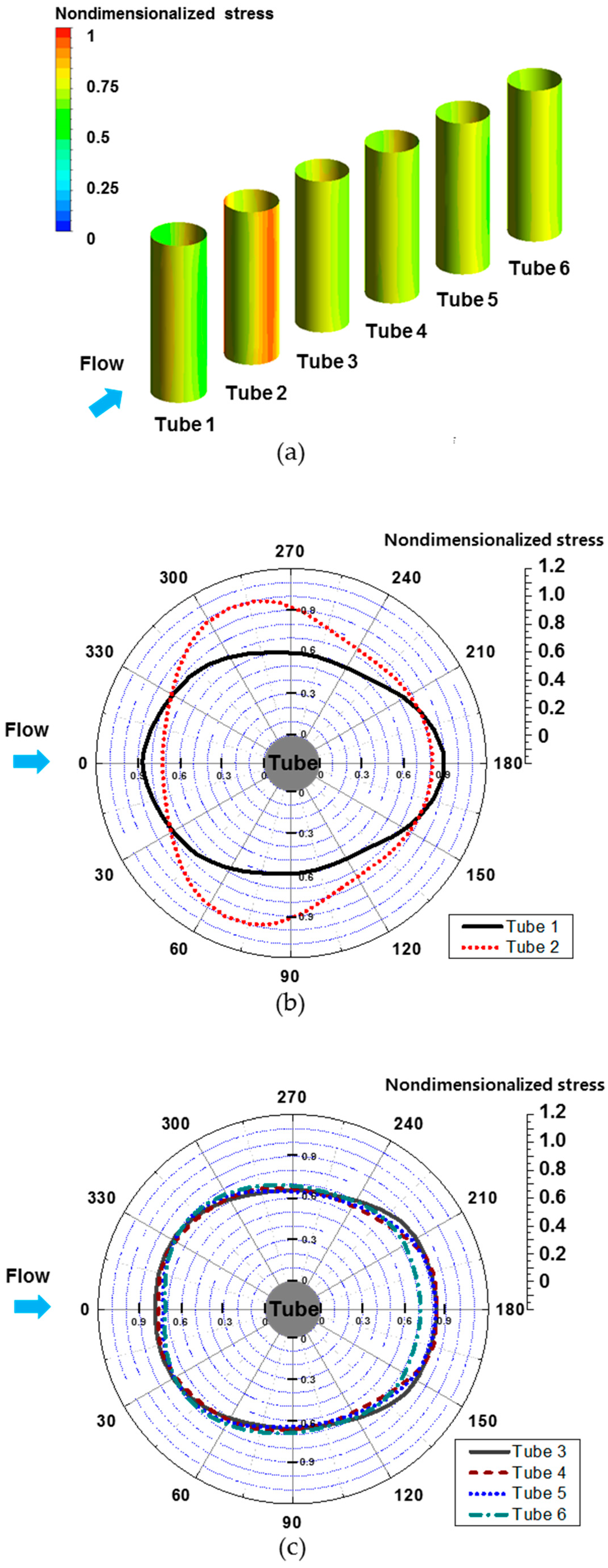
© 2016 by the authors; licensee MDPI, Basel, Switzerland. This article is an open access article distributed under the terms and conditions of the Creative Commons Attribution (CC-BY) license (http://creativecommons.org/licenses/by/4.0/).
Share and Cite
Choi, S.M.; Park, J.S.; Sohn, H.-S.; Kim, S.H.; Cho, H.H. Thermal Characteristics of Tube Bundles in Ultra-Supercritical Boilers. Energies 2016, 9, 779. https://doi.org/10.3390/en9100779
Choi SM, Park JS, Sohn H-S, Kim SH, Cho HH. Thermal Characteristics of Tube Bundles in Ultra-Supercritical Boilers. Energies. 2016; 9(10):779. https://doi.org/10.3390/en9100779
Chicago/Turabian StyleChoi, Seok Min, Jun Su Park, Ho-Seong Sohn, Seon Ho Kim, and Hyung Hee Cho. 2016. "Thermal Characteristics of Tube Bundles in Ultra-Supercritical Boilers" Energies 9, no. 10: 779. https://doi.org/10.3390/en9100779





